

Pac-Man: When Monsters Became Ghosts
By Scott Stilphen
Here's a piece of trivia - did you know that the ghosts in Pac-Man weren't always ghosts? Next time you see a Pac-Man machine, check out the instruction card printed on the monitor glass:
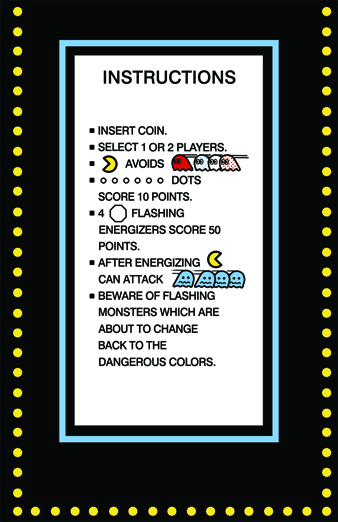
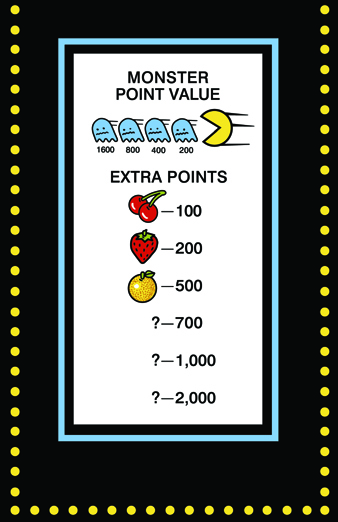
Before anyone thinks Midway was the first to call them monsters, the instructions on the monitor glass for the original Japanese Namco Puck Man game also refer to them as monsters:

A bit of background: the 4 monsters (Blinky, Pinky, Inky and Clyde, as they were known outside Japan) were based on Obake no Q-Taro, a famous cartoon ghost (TV series 1965-1967). Q-taro is a monster who lives with the Ohara family. He can fly and make his body transparent, but he cannot turn his body into other things like other monsters do. He is a bit of a scatterbrain and is always making mistakes and causing trouble.
Fans of the TV show Taxi might even recall this famous scene from the episode "The Unkindest Cut" (originally aired February 25th, 1982) with Louie De Palma describing the game to Reverend Jim:
This was done at the height of Pac-Man's popularity and might have been the first example of a video game being used as a plot or subplot device on a television show.
Pac-Man was also featured on an episode of the Barbara Mandrell and the Mandrell Sisters featuring Johnny Cash and June Carter (originally aired February 27th, 1982 LINK). 'Monsters' is mentioned several times.
Namco's original flyer also refers to them as monsters ("Power up!! The monster...."):
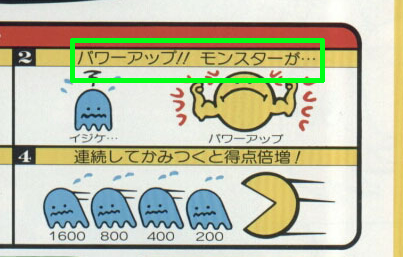
Using the original arcade flyers for reference (www.arcadeflyers.com), every arcade Pac-Man game before 1983 (with the exception of Ms. Pac-Man, which came out after VCS Pac-Man) referred to them as monsters: Pac-Man (both monsters and ghost monsters), Baby Pac-Man (October 1982), Pac-Man Plus (1982, which was just an upgrade kit for Pac-Man), Super Pac-Man (October 1982) and the Mr. & Mrs. Pac-Man (May 1982) pinball game. Same with the hand-held games by Coleco Pac-Man (1981) and Ms. Pac-Man (1983), Tomytronic's Pac-Man (1981), and Nelsonic's Pac-Man (1982) games. Entex's PacMan2 AKA HungryPac (1981) calls them ghosts, but this was an unlicensed version that Coleco sued Entex over.
Every strategy guide book released prior to the VCS version referred to them as monsters as well:
| Break A Million! At Pac-Man (1982) - monsters (arcade) Guide to the Video Arcade Games (June 1982) - refers to them as both monsters and ghosts. Be A Home Videogame Superstar - Secrets To The Best Games For Your Atari VCS (1983) - refers to them as both monsters and ghosts. How To Beat Atari, Intellivision, and Other Home Video Games (1982) - monsters (VCS) How to Beat the Video Games (1982) - monsters (arcade) How to Master Home Video Games (March 1982) - monsters (VCS). The author played an advanced copy of the game before it was released. He also refers to energizers as power pills and bonus items as vitamins but doesn't call the dots wafers. How to Master the Video Games (November 1981) - monsters (arcade) How to Win at Home Video Games (1982) - ghosts (VCS) How to Win at Pac-Man (1982) - monsters (arcade). Incorrectly states the VCS version was released in January! (pg 30). Refers to them in the VCS version as both monsters and ghosts. How to Win at Video Games: A Complete Guide (1982) - monsters (arcade Pac-Man and Ms. Pac-Man) except for one drawing of the screen where the monsters are called "ghost monsters". Other home versions are covered. With Atari's, the author points out all the differences with it compared to the arcade version, and notes, "All of the monsters are yellow in the Atari game, and they blink rapidly on and off during the game. Incidentally, Atari doesn't call them monsters but refers to them as ghosts."
How to Win at Video Games: Complete Strategies for Top Arcade Games (1983) - monsters (Ms. Pac-Man) |
So, when and why did Namco start calling monsters ghosts? It all started with the Atari VCS/2600 version. Even before the game was released, early Atari 1981 catalogs referred to them as ghosts:


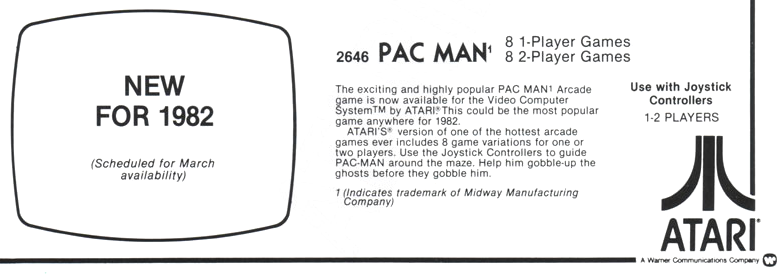
The VCS game was made in 1981 (hence the onscreen copyright date) and released in March 1982. April 3rd, 1982 was the official release date for it, but the game was actually available a week or two before that. Both the VCS/2600 and 5200 manuals are very clear about calling them ghosts. There were 2 exceptions. The first was with Atari's 2nd Log Book (pg. 8):
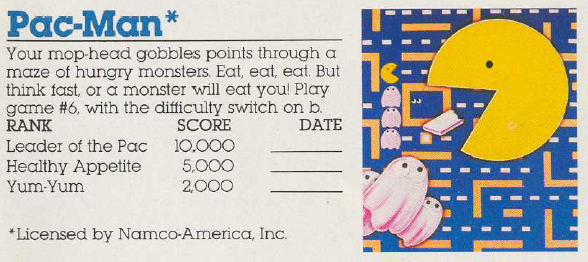
The other was with Atari’s 400/800 computer version, in which the manual refers to them as "goblins", otherwise Atari never called them monsters (although, Roklan (who programmed the Atari 400/800 version) did refer to them as monsters in the original source code):
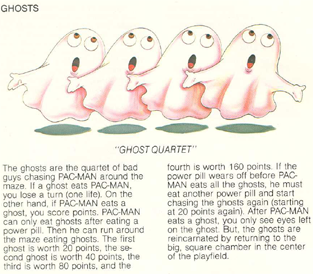

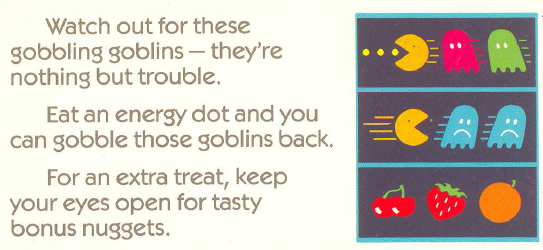
A similar goblin reference was made by Atari in the July/Aug 1982 issue of Atari Age ("Pac-Man and his ghostly gobblin' friends" - pg. 3), and by Electronic Games in the September 1982 issue (Strategy Session - "Gobbling Points with Pac-Man" - pg. 28).
A popular set of stickers (whether or not these were officially licensed by Midway is unknown) at the time mentions National Pac-Man Day (something Atari created to promote the release of their VCS version) but also refers to them as monsters:
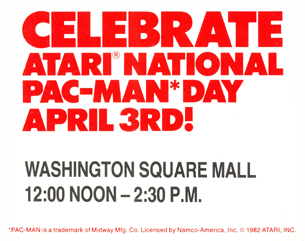
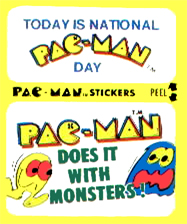
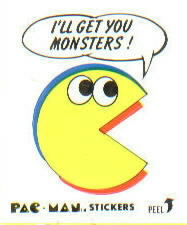
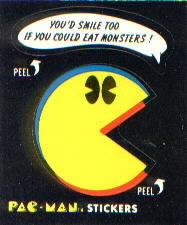
Thanks to the limitations of the VCS, the manual for the VCS version labeled them ghosts, probably due to their flickering appearance. Much like how the graphics in VCS Space Invaders didn't resemble the arcade version, Atari took a little creative licensing with Pac-Man as well; besides monsters becoming ghosts, dots became "wafers", energizers became "power pills" (the original Midway arcade flyer also referred to energizers as "Power Capsules"), and bonus items became "vitamins". Undoubtedly someone in Atari's Marketing department relabeled them ghosts in an effort to explain their flickering appearance (having flickering ghosts is more acceptable than having flickering monsters). The book, Racing the Beam, also comes to the same conclusion (pg. 74). It was the same reason for calling the dots (which looked like dashes) wafers and the blocky bonus items (nothing more than a square inside a square) vitamins, since it didn't resemble fruit or anything else.
What's interesting is, the original cover artwork by artist Hiro Kimura clearly depicts monsters chasing Pac-Man:
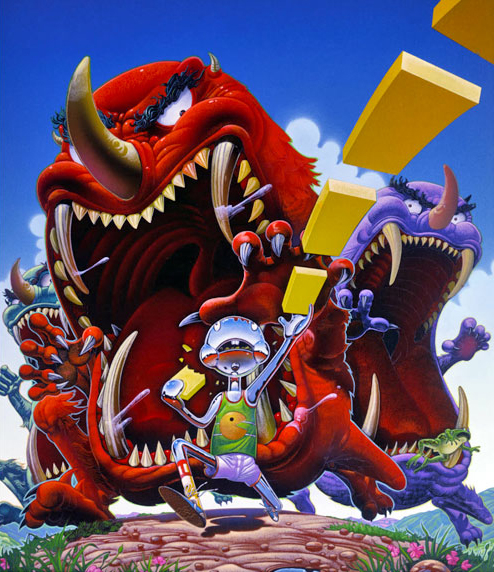
According to Kimura, he was 80% finished with it when Atari's management asked him to change direction since they were concerned the "ghosts" in it were too ferocious.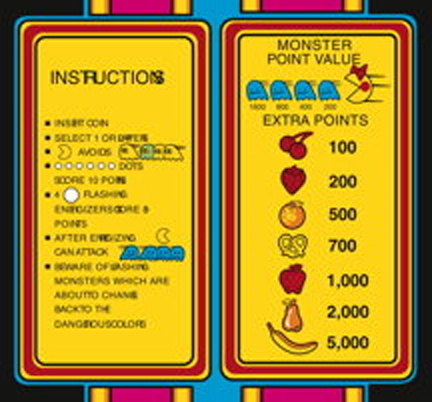
As a result of Pac-Man's popularity, nearly 8 million VCS Pac-Man carts were sold between 1982-83 alone, making it the best-selling VCS cartridge ever, and the number of carts and manuals far-outnumbered the number of arcade games. Even though most owners probably didn't bother to read the manual (given this would have been during the peak of Pac-Man's popularity, how many needed to?), that's still a lot of manuals out in circulation, so surely some of those must have been read.
A few months after VCS Pac-Man was released, Midway released their Pac-Man sequel, Ms. Pac-Man. Although both the manual and flyer for it refers to the monsters as ghosts, very few people outside the industry would have seen either the flyer or manual. The arcade monitor bezel still referred to them as monsters, and to the millions of people playing the 100k Ms. Pac-Man machines, that's what they would have read, and besides, these were released well after Atari's Marketing had started referring to them as ghosts.
The arcade Ms. Pac-Man flyer is dated 1982 (no month), but even if a more specific date was stamped on it, that wouldn’t prove the game had been released by then (for one thing, flyers often came out at least a month before a game shipped, and for another, someone could have predated it after it shipped). It's also worth noting that an article in the May 1982 issue of Electronic Games (page 32) features a statement from Midway spokesperson Stan Jarocki that a sequel (Ms. Pac-Man) was being planned, and an ad for the game first appeared in the August 1982 issue of Video Games (below). Magazines typically had a 2-month post date on them at the time they were released.
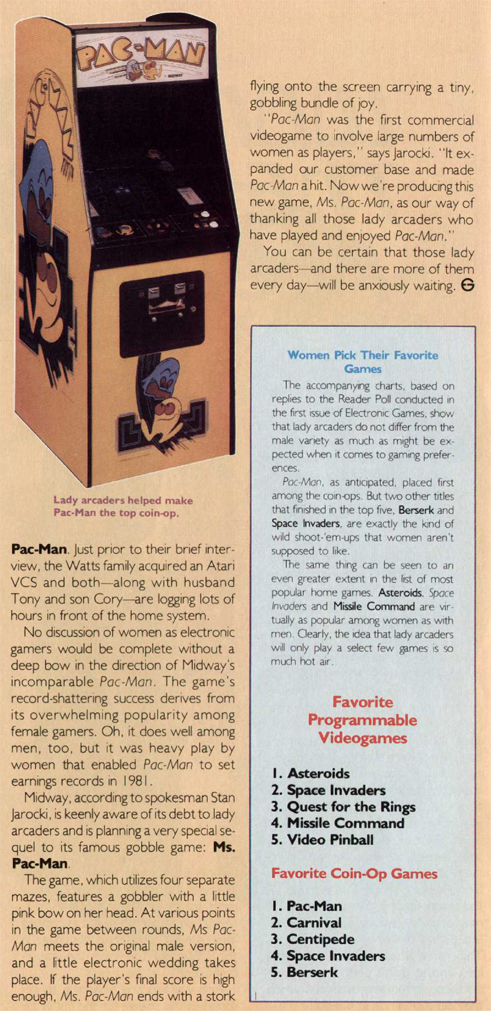
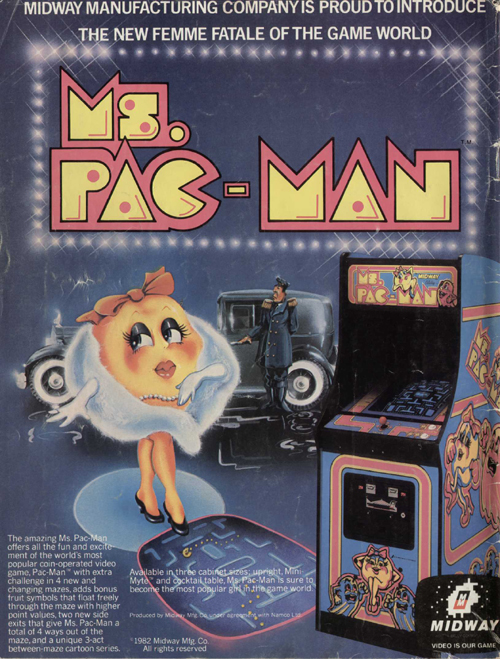
During Ms. Pac-Man's development, it went through several different names (Crazy Otto, Miss Pac-Man, Pac-Woman, etc). While the game was still called Miss Pac-Man, an early Midway concept drawing was created in late 1981 by Tony Ramunni, which clearly shows the monsters depicted as such:
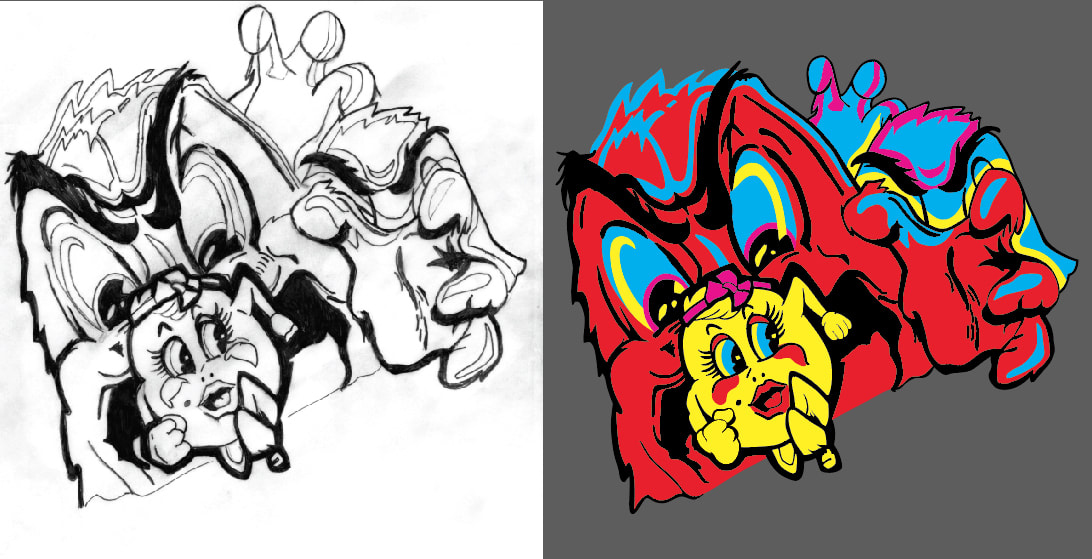
Steve Golson in his 2014 keynote at MIT (January 8th, 2012) about the history of Ms. Pac-Man's development never refers to the monsters as ghosts. Some historical (or is that hysterical?) revisionists and self-proclaimed Wikipedia sheriffs claim the arcade game was released in January 1982, because that's the date that's printed on the manual (this same skewed logic of theirs has convinced them VCS Pac-Man was somehow started before VCS Asteroids, or that VCS Adventure was released in 1979 instead of 1980, or that VCS Space Invaders wasn't released until December 1980, or countless other questionable claims of theirs, like this...), but it's worth noting the schematics within said manual show at least 2 different revision dates from December 1981. Actually, the copyright for the game was filed in January 1982 (PA0000140275). The game's release was announced in the February 1982 issues of RePlay and Vending Times, and the March 15th, 1982 issue of Play Meter. An internal Atari memo (dated 7/25/83) lists the arcade game's release as March as well:
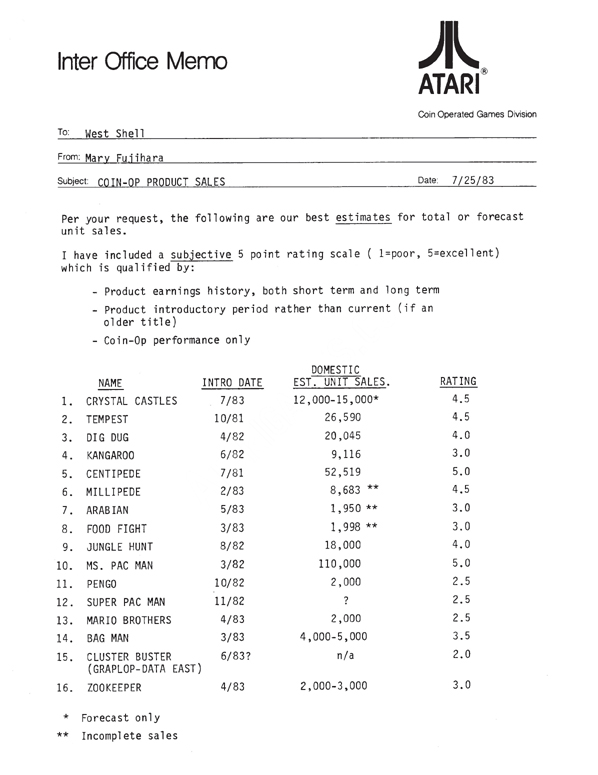
An article from author Benj Edwards states the game made its "worldwide public debut" on February 3rd, 1982, during a press conference held by Namco at Castle Park Entertainment Center in Sherman Oaks, CA. Here's some newspaper articles (courtesy of Benj Edwards):

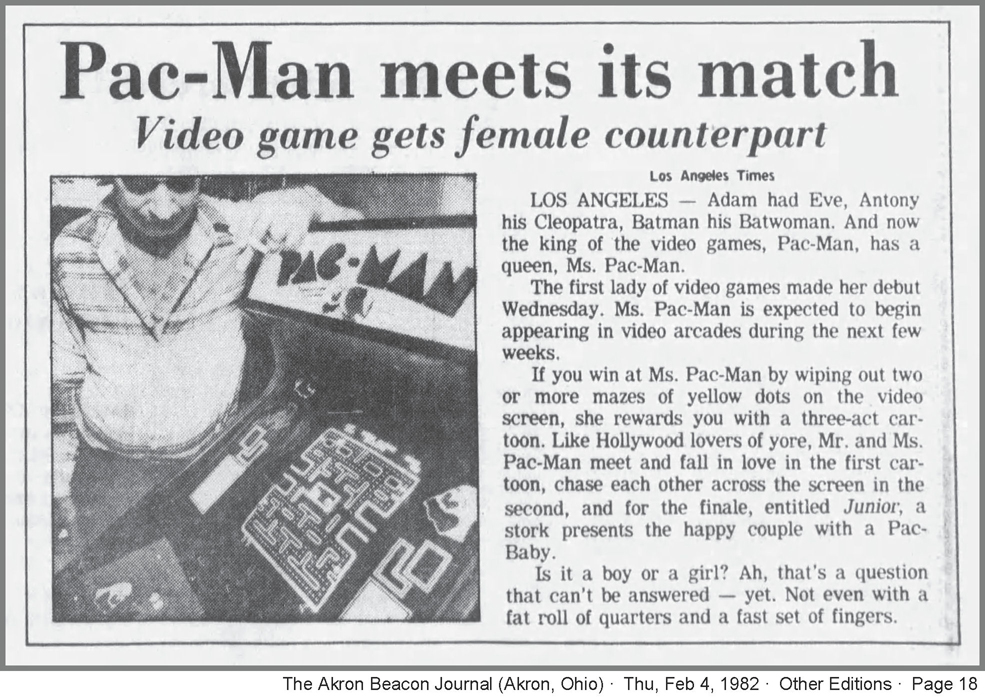
Note the article states "Ms. Pac-Man is expected to begin appearing in video arcades during the next few weeks.", which puts the release date in late February at the earliest, but more than likely it was indeed March - mere weeks or even days before VCS Pac-Man was released.
A Pac-Man board game released by Milton Bradley in 1982 also refers to them as ghosts (as did their 1983 Ms. Pac-Man board game), but this too was likely released after VCS Pac-Man, making it the 2nd officially-licensed Namco Pac-Man product to start calling them ghosts. But I doubt board games - even Pac-Man ones - sold in the millions like VCS Pac-Man.
So, if most people didn't read the VCS manual, and even less played the board game, what would have been the other factor in this collective reinterpretation of turning Pac-Man's monsters into ghosts?
Most likely that would have been Hanna-Barbera's TV cartoon Pac-Man show (that debuted on September 25th, 1982), which referred to them as "Ghost Monsters":
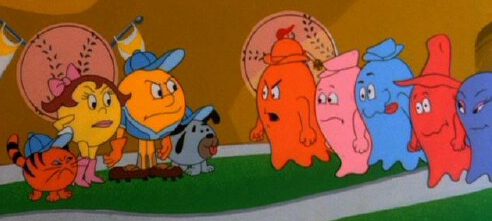
In an interview with Joseph Barbera in the January 1984 issue of Electronic Games magazine (pg. 26), he related the challenge of adapting the game to an animated show - "Next came Network's Programs and Practices, and they said we can't show the eating of the characters on-screen. It's too violent. So, how do you do that when it's the central action of the game? We had to invent a new way of doing it so there is no pain, gore or violence. We did it with a little magic, where little bubbles pop up whenever they do that, and then they're immediately restored. They're not really human, you see. We used the ghosts from the game..." (on a related note, you can read an interview with Marty Ingels, who voiced Pac-Man, in the February 1983 issue of Video Games magazine, page 10).
This would have been around the time when Bally/Midway started calling them ghosts as well, starting with Jr. Pac-Man (October 1983). I don't know about Pac & Pal (July 1983), Pac-Man & Chomp Chomp (which was a variant of Pac & Pal, to tie in more closely to the TV cartoon show), and Professor Pac-Man (August 1983), but after that, Pac-Man 25th Anniversary and Pac-Man Battle Royal both called them ghosts. Pac-Land (August 1984) is based on the TV cartoon show and was done by Namco, who refers to them as monsters on the flyer. Pac-Mania (November 1987) is the one exception - it referred to them as ghosts everywhere (cabinet, manual, and flyers) except in the game itself, where it referred to them as monsters:
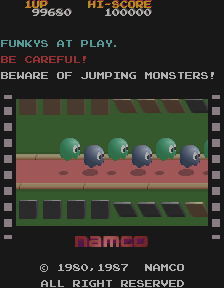
But the show's reference is something that could have been changed at almost any point during its development - right up until the end (it's unknown if the voice work was done before or after the animation was completed). The show also referred to energizers as "power pellets". The show ran from September 1982 to November 1983.
Given the context of the original game, the term "monsters" is more appropriate. They were locked within the maze, just like the player, and when they were 'eaten', they had to go back to a safe area to regenerate (much like how some lizards can regenerate damaged or missing parts of their bodies). And aside from the fact each were a different color (wouldn't all ghosts be the same color?), the most compelling evidence for them being monsters is revealed during the 2nd and 3rd intermissions, where part of the monster's body is first torn away to reveal its leg, and then later all but removed:


So apparently they weren't going back to the monster pen to regenerate so much as to repair their clothes! How many old episodes of say, Scooby-Doo!, had "ghosts" running around, only for the protagonists to pull the sheet off and expose them for the mortal beings they really were? In my opinion, that's exactly what the 3rd act/intermission shows - they're not "ghosts" but "monsters" in disguise. Another way to look at it is, if you can get that far into the game, then you probably don't fear them as much :) However, once the TV show depicted them as floating, sometimes disembodied creatures, there was no going back. Pac-Man "ghosts" became part of the lexicon, so much that most people today are unaware they were ever called monsters.
As for why Namco went along with the change, who knows? They certainly didn't care that VCS Pac-Man was only remotely similar to the original version. Most companies such as Namco were only concerned with collecting their licensing fees; holding licensees accountable for maintaining a level of accuracy with ports of their games simply wasn't an issue with them.
What does Pac-Man's creator, Toru Iwatani say about it? I found an interview with Iwatani in 1986 where he refers to them several times as both monsters and ghosts, so that's not much help (and in later interviews he refers to them as simply ghosts). But, he initially describes them as "ghost-shaped monsters", which is the best description of them after all.
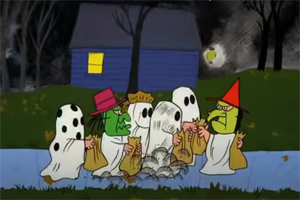
Are these ghosts,
or ghost-shaped kids?